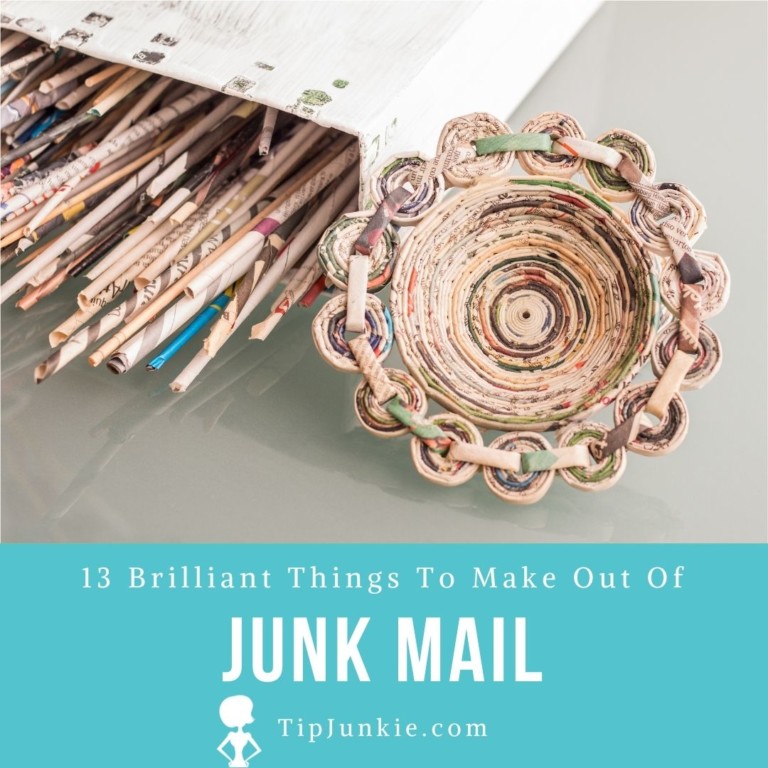Can You Compost Junk Mail? Discover the Truth and Sustainable Solutions

As concerns about waste management and environmental sustainability grow, many people are seeking creative ways to reduce their carbon footprint. One common yet often overlooked source of waste is junk mail. While it may seem harmless, the accumulation of unsolicited advertisements can contribute significantly to landfill waste. In this article, we will explore whether junk mail can be composted, uncovering the truth behind this practice and discussing sustainable solutions that can help mitigate its environmental impact. Join us as we delve into the practicality of composting junk mail and discover alternative methods for managing this pervasive issue.
Can You Compost Junk Mail?
Yes, you can compost junk mail, but it is essential to consider the materials and processes involved. Junk mail often contains various types of paper, some of which might be acceptable for composting while others could potentially harm your compost pile. Generally, plain paper without heavy inks, glossy finishes, or plastic coatings can be composted, as they will break down into valuable organic matter. However, items like credit card offers, glossy advertisements, and plasticized materials should be avoided, as they do not decompose well and can introduce harmful chemicals into your compost. Always shred the paper to increase surface area and speed up the decomposition process, making it easier for microorganisms to break it down effectively.
What Types of Junk Mail Can Be Composted?
You can compost junk mail that is made from plain, uncoated paper such as brochures, flyers, and envelopes without plastic windows or glossy finishes. Be cautious with colored ink, as some dyes may not break down well. The best practice is to stick to items that use water-based inks, which are generally safer for composting. Always shred or tear the junk mail into smaller pieces to help it break down faster and integrate more easily into your compost pile.
Are There Any Risks with Composting Junk Mail?
Composting junk mail is not without its risks, particularly concerning the use of toxic inks and additives. Many marketing materials are printed with dyes and varnishes that can contain heavy metals and other harmful chemicals. When selecting what to compost, look for junk mail printed with soy-based inks or similar eco-friendly materials. Additionally, avoid composting any junk mail that may contain plastic coatings or films, as these can disrupt the composting process and lead to contamination in your finished compost.
How to Prepare Junk Mail for Composting?
To prepare your junk mail for composting, start by removing any non-paper elements like plastic windows or synthetic components. Next, shred or tear the paper into smaller pieces to enhance decomposition and facilitate microbial activity. If possible, separate the printed papers by color, as darker inks may break down more slowly. It's advisable to mix the prepared junk mail with green materials such as kitchen scraps or grass clippings to create a balanced compost pile that has adequate nitrogen and carbon ratios.
What Alternatives Exist for Junk Mail Aside from Composting?
Aside from composting, you can consider alternatives for managing junk mail. Recycling is a viable option, as long as the paper materials meet your local recycling guidelines. You might also choose to reduce the amount of junk mail you receive by opting out of mailing lists or using services that consolidate your mail preferences. Another option is to reuse certain types of junk mail by crafting or using it for other purposes, such as making notepads or paper-mâché projects, giving it a second life while keeping it out of landfills.
How Does Junk Mail Impact the Environment?
The environmental impact of junk mail can be significant, contributing to deforestation, waste accumulation, and generally increasing the carbon footprint associated with its production and disposal. When junk mail is generated, it often results in the unnecessary use of resources, including water, energy, and raw materials. Even though composting can mitigate some of these impacts by returning nutrients to the soil, it still poses challenges, such as the potential for chemical leaching if contaminated materials are not properly managed. Addressing this issue increasingly involves a collective effort towards reducing paper waste at the source through judicious consumption habits and recycling initiatives.
| Junk Mail Type | Compostable |
|---|---|
| Plain paper flyers | Yes |
| Glossy advertisements | No |
| Envelope (without plastic window) | Yes |
| Credit card offers | No |
| Catalogs (non-glossy) | Yes |
Can junk mail go in compost?

Junk mail, often perceived as a nuisance, raises questions about its recyclability and compostability. The answer to whether junk mail can go in compost depends on its materials and the specific composting guidelines you follow. Here is a detailed exploration of the topic.
Understanding Junk Mail Composition
Junk mail can consist of various materials, including paper, plastics, and sometimes even metallic elements. Knowing what your junk mail is made of is crucial for determining its compostability. Most common materials in junk mail include:
- Paper - Typically made from recycled or virgin sources.
- Ink - Often soy-based or petroleum-based, influencing its safety.
- Plastic - Some junk mail includes plastic windows or coatings that are not compostable.
Identifying Compostable Paper Types
Not all paper used in junk mail is equal. To compost junk mail effectively, you need to check if it meets composting standards.
- Uncoated Paper - This type is usually compostable and breaks down easily.
- Colored Paper - While many colored papers are compostable, check for harmful dyes.
- Glue - The type of adhesive used may affect compostability; natural adhesives are preferable.
Importance of Removal of Non-Compostable Elements
Before adding junk mail to your compost, it’s essential to remove any elements that may hinder the composting process. These include:
- Plastic Windows - Often found in envelopes, they are not biodegradable.
- Staples or Paper Clips - These metal elements will not break down in compost.
- Synthetic Coatings - Any glossy or coated paper should be avoided.
Local Composting Regulations
Composting practices can vary greatly based on local guidelines, making it vital to understand what is permissible in your area. Key considerations include:
See also:
- Community Guidelines - Some regions have specific rules about what can be composted.
- Municipal Facilities - Check if the local compost facility accepts junk mail.
- Educational Resources - Local extensions or environmental groups can provide useful information.
Effects on Compost Quality
When composting junk mail, it’s crucial to ensure it doesn’t negatively affect the quality of your compost. Factors to be aware of include:
- Contaminant Risk - Non-compostable materials can introduce toxins.
- Carbon to Nitrogen Ratio - Paper adds carbon, but balance with nitrogen-rich materials is necessary.
- Odor Management - Avoiding excess paper can help prevent bad smells in your compost.
Is shredded mail good for compost?

Shredded mail can be a useful addition to compost, but there are several factors to consider to ensure it contributes positively to the composting process. Shredded paper is generally carbon-rich, which means it can help balance the carbon-to-nitrogen ratio in your compost pile. However, not all shredded mail is suitable for composting, especially if it contains certain materials or inks.
Benefits of Shredded Mail in Compost
Including shredded mail in your compost offers various benefits that can enhance the overall quality and health of the compost. These benefits include:
- Carbon Source: Shredded mail serves as a carbon-rich material, which is essential for creating a balanced compost mixture.
- Improvement of Structure: The shredded paper can help improve the aeration and structure of the compost pile, facilitating better microbial activity.
- Absorption of Moisture: Shredded paper can absorb excess moisture, preventing your compost from becoming too soggy.
Types of Paper to Avoid in Compost
Not every type of shredded mail is safe for composting. It's important to be selective about which papers you include to avoid potential issues:
- Glossy Paper: Avoid glossy or coated paper because it may contain chemicals that do not break down safely.
- Colored Inks: Papers printed with colored inks may also contain harmful dyes that can leach into the compost.
- Plastic-Laminated Material: Any mail that has a plastic coating will not decompose and should be discarded separately.
Best Practices for Composting Shredded Mail
To ensure that shredded mail contributes effectively to your compost pile, follow these best practices:
- Shred Thoroughly: The finer the paper is shredded, the faster it will decompose. Aim for small pieces to enhance breakdown.
- Mix Well: Combine shredded mail with a variety of nitrogen-rich materials, such as kitchen scraps, to achieve a balanced mix.
- Monitor Moisture Levels: Keep an eye on the moisture content of your compost, as shredded paper can absorb a lot of water.
Impact on Nutrient Content
The impact of shredded mail on the nutrient content of compost can vary. It’s essential to understand how it interacts with other compost materials:
- Nutrient Contribution: While shredded mail itself does not add significant nutrients, it helps improve the overall structure that allows nutrient-rich materials to break down more effectively.
- Microbial Activity: The presence of paper can support microbial life by providing a habitat, indirectly enhancing nutrient availability.
- Decomposition Rate: If not mixed properly, shredded mail can slow down decomposition rates, impacting nutrient release over time.
Environmental Considerations
When composting shredded mail, there are environmental considerations to keep in mind that can affect your composting practices:
- Recycling Alternatives: Consider whether shredding and composting is a more sustainable option compared to recycling, especially for high-quality paper.
- Biodegradability: Most plain shredded paper is biodegradable; however, the presence of contaminants can complicate the composting ecosystem.
- Reducing Waste: Composting shredded mail can be an effective way to reduce landfill waste while enriching your garden's soil.
Can you put junk mail in the recycle bin?
Yes, you can put junk mail in the recycle bin, as it is typically made of recyclable paper materials. However, there are a few considerations to keep in mind to ensure you are recycling correctly and efficiently.
What is Junk Mail?
Junk mail refers to unsolicited promotional materials sent through the postal system. These items can include credit card offers, catalogs, flyers, and other advertisements. While they may seem like clutter, they are usually made from paper that can be recycled.
- Definition: Junk mail encompasses various forms of direct mail intended for mass distribution.
- Examples: Common types of junk mail include coupons, catalogs, and flyers.
- Environmental Impact: Reducing junk mail can decrease waste and the carbon footprint associated with printing and distributing these materials.
Are There Any Exceptions?
While most junk mail can be recycled, some types may not be recyclable due to materials used. For example, items with plastic windows, glossy finishes, or heavy ink can be problematic in recycling processes.
- Plastic Windows: Junk mail envelopes with transparent plastic windows are often not accepted in recycling bins.
- Glossy Paper: Certain glossy papers may not break down effectively during the recycling process.
- Heavy Inks: Items printed with heavy inks can contaminate the recycling stream and should ideally be disposed of otherwise.
How to Prepare Junk Mail for Recycling?
Before placing junk mail in the recycling bin, it is essential to prepare it properly to maximize its recycle-ability. This can include removing any non-paper elements and sorting various types of materials.
See also:
- Remove Non-Paper Components: Take out plastic cards or any non-paper materials from junk mail before recycling.
- Flatten Envelopes: Flattening envelopes helps to save space and ensures better processing in recycling facilities.
- Sort Paper Types: If possible, separate glossy papers from standard paper before putting them in the recycle bin.
Benefits of Recycling Junk Mail
Recycling junk mail has various environmental benefits that contribute to sustainability and resource conservation. Physical benefits include reducing landfill waste and conserving natural resources.
- Reduces Waste: Recycling helps divert junk mail from landfills, reducing overall waste.
- Conserves Resources: Recycling paper reduces the need for virgin fibers, thus preserving trees and forests.
- Energy Savings: The recycling process often uses less energy compared to creating new products from raw materials.
How to Reduce Junk Mail?
While recycling junk mail is an excellent way to manage waste, reducing the amount of junk mail received is even more beneficial. There are several methods and services available to help manage and minimize junk mail.
- Opt-Out Services: Utilize services like the Direct Marketing Association’s Mail Preference Service to reduce junk mail.
- Contact Companies Directly: Reach out to companies that send you junk mail and request removal from their mailing lists.
- Use Electronic Communication: Opt for digital subscriptions or online catalogs to reduce the need for physical mail.
What can you do with junk mail?

Junk mail, often referred to as unsolicited or unwanted promotional material, can seem like a nuisance, but there are various ways to manage it effectively. Here are several options you can consider when dealing with junk mail:
1. Recycle Junk Mail
Recycling is one of the most environmentally responsible actions you can take with junk mail. Most junk mail consists of paper, which can easily be processed and reused. To ensure effective recycling:
- Check Local Guidelines: Different regions have various recycling rules, so confirm what is accepted.
- Sort Materials: Remove non-paper elements such as plastic windows or staples to avoid contamination.
- Compost if Appropriate: Some paper types may be compostable, particularly uncoated or non-glossy materials.
2. Use it for Creative Projects
Instead of discarding junk mail, it can serve as a resource for various arts and crafts projects, especially for children. Some ideas include:
- Collage Making: Use pictures and text from junk mail to create collages for art projects.
- Origami: Brightly colored mail can be transformed into unique origami shapes.
- Scrapbooking: Incorporate elements of junk mail into scrapbooks to add unique flair.
3. Organize and Keep Important Information
Sometimes junk mail contains important information that could be useful in the future. Here are ways to organize this effectively:
- Create a Filing System: Use folders or binders to store relevant promotional materials that may benefit you.
- Categorize by Type: Sort materials into categories such as finance, travel, or food to easily find them when needed.
- Highlight Important Offers: Use markers to emphasize significant deals or discounts that catch your eye.
4. Shred Sensitive Documents
Junk mail can often contain personal information that should not be disclosed. Shredding these materials helps protect your identity and privacy. Here's how:
- Identify Sensitive Information: Look for your name, address, or financial details before disposing of mail.
- Invest in a Shredder: A personal shredder can be a worthwhile investment for safely disposing of sensitive documents.
- Follow Local Laws: Ensure compliance with local regulations regarding the disposal of personal documents.
5. Opt-Out of Junk Mail Lists
If you find yourself overwhelmed with junk mail, you can take steps to reduce the amount you receive by opting out. Here are practical steps:
- National Do Not Mail List: Check if your country has a national registry that allows you to opt-out of unsolicited mail.
- Contact Specific Companies: Reach out to companies directly to request removal from their mailing lists.
- Use Services: Employ third-party services that specialize in reducing your junk mail volume effectively.
Questions from Our Readers
Can I compost all types of junk mail?
You cannot compost all types of junk mail. Most paper-based junk mail, like flyers and brochures, can be composted as long as they are free from plastic coatings or metallic inks. However, any mail that contains plastic, glossy finishes, or synthetic materials should be disposed of in regular trash.
What should I do with junk mail that has plastic windows?
Junk mail with plastic windows is not suitable for composting. The plastic can take a long time to decompose, leaving harmful residues in the compost. It’s best to remove the plastic window before composting the paper portion or to simply throw it away.
How can I ensure my compost pile is healthy when adding junk mail?
To maintain a healthy compost pile, it’s essential to balance the nitrogen-rich green materials with the carbon-rich brown materials. When adding compostable junk mail, tear it into small pieces to facilitate decomposition and mix it well with other organic materials to promote aeration and moisture balance.
Is composting junk mail good for the environment?
Yes, composting junk mail is beneficial for the environment as it reduces landfill waste and enriches the soil with valuable nutrients. By composting, you are helping to close the recycling loop, and when done correctly, it can contribute to a healthier ecosystem.
See also:

If you want to read more articles like Can You Compost Junk Mail? Discover the Truth and Sustainable Solutions, we recommend you check out our Compost category.
Leave a Reply

Related Articles